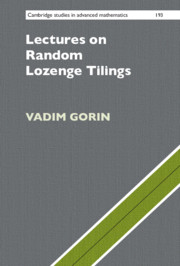
-
Select format
-
- Publisher:
- Cambridge University Press
- Publication date:
- 31 August 2021
- 09 September 2021
- ISBN:
- 9781108921183
- 9781108843966
- Dimensions:
- (229 x 152 mm)
- Weight & Pages:
- 0.52kg, 262 Pages
- Dimensions:
- Weight & Pages:
You may already have access via personal or institutional login
Book description
Over the past 25 years, there has been an explosion of interest in the area of random tilings. The first book devoted to the topic, this timely text describes the mathematical theory of tilings. It starts from the most basic questions (which planar domains are tileable?), before discussing advanced topics about the local structure of very large random tessellations. The author explains each feature of random tilings of large domains, discussing several different points of view and leading on to open problems in the field. The book is based on upper-division courses taught to a variety of students but it also serves as a self-contained introduction to the subject. Test your understanding with the exercises provided and discover connections to a wide variety of research areas in mathematics, theoretical physics, and computer science, such as conformal invariance, determinantal point processes, Gibbs measures, high-dimensional random sampling, symmetric functions, and variational problems.
Reviews
‘The lectures provide connections between random tilings and many areas in mathematics and theoretical physics, and include an exhaustive reference list. Mathematicians and others interested in the hows and whys of this intriguing area would be well-served by consulting this text.’
Thomas Polaski Source: Mathematical Reviews/MathSciNet
‘It seems that the reviewed book is the first introductory text about this fascinating topic. The release of this book is a great event for everyone interested in this problem.’
Anton Shutov Source: zbMATH
Contents
Metrics
Altmetric attention score
Full text views
Full text views help Loading metrics...
Loading metrics...
* Views captured on Cambridge Core between #date#. This data will be updated every 24 hours.
Usage data cannot currently be displayed.
Accessibility standard: Unknown
Why this information is here
This section outlines the accessibility features of this content - including support for screen readers, full keyboard navigation and high-contrast display options. This may not be relevant for you.
Accessibility Information
Accessibility compliance for the PDF of this book is currently unknown and may be updated in the future.


